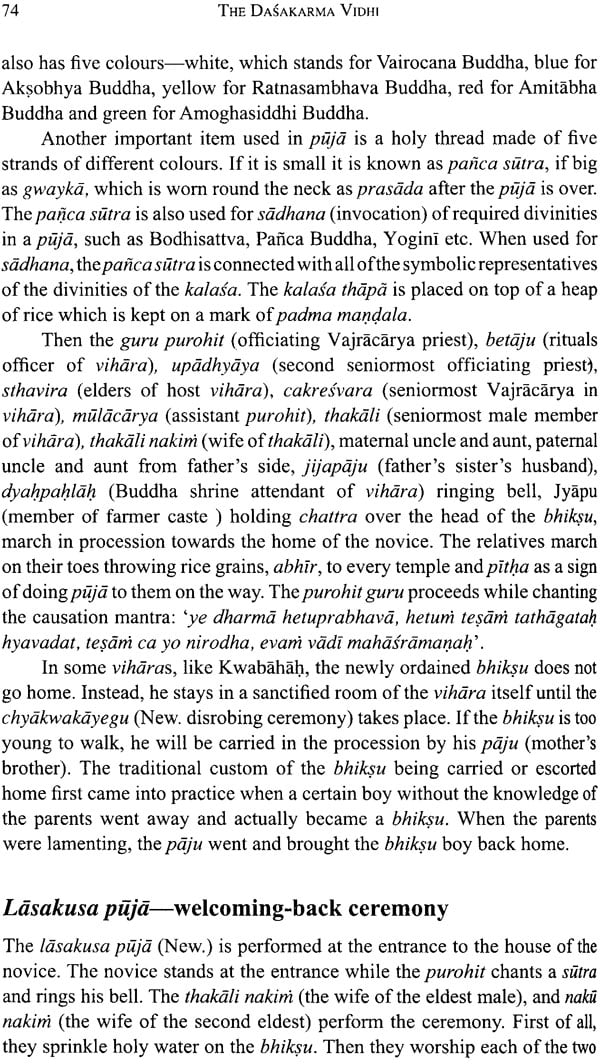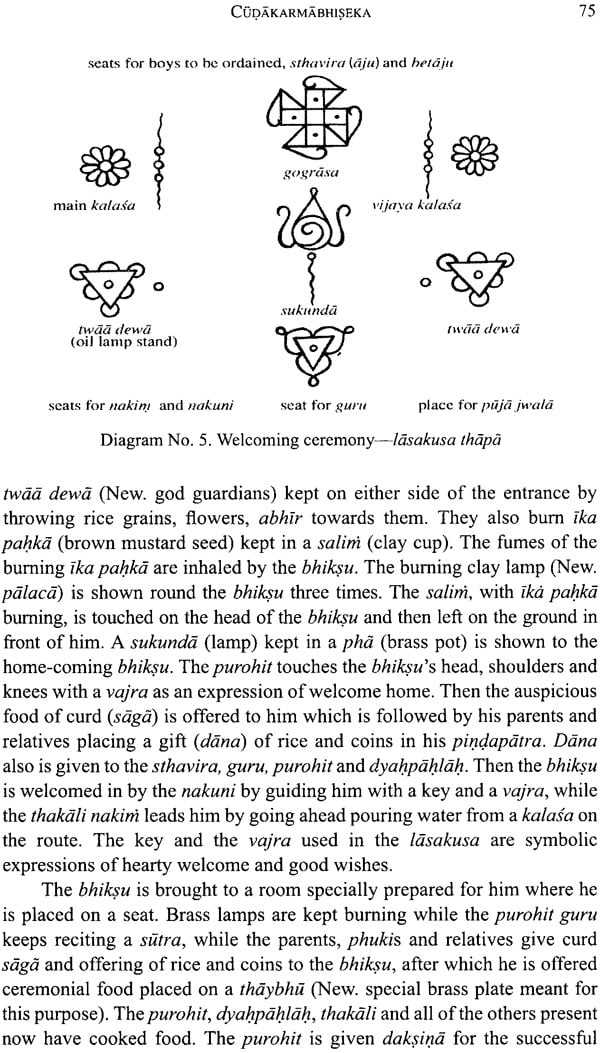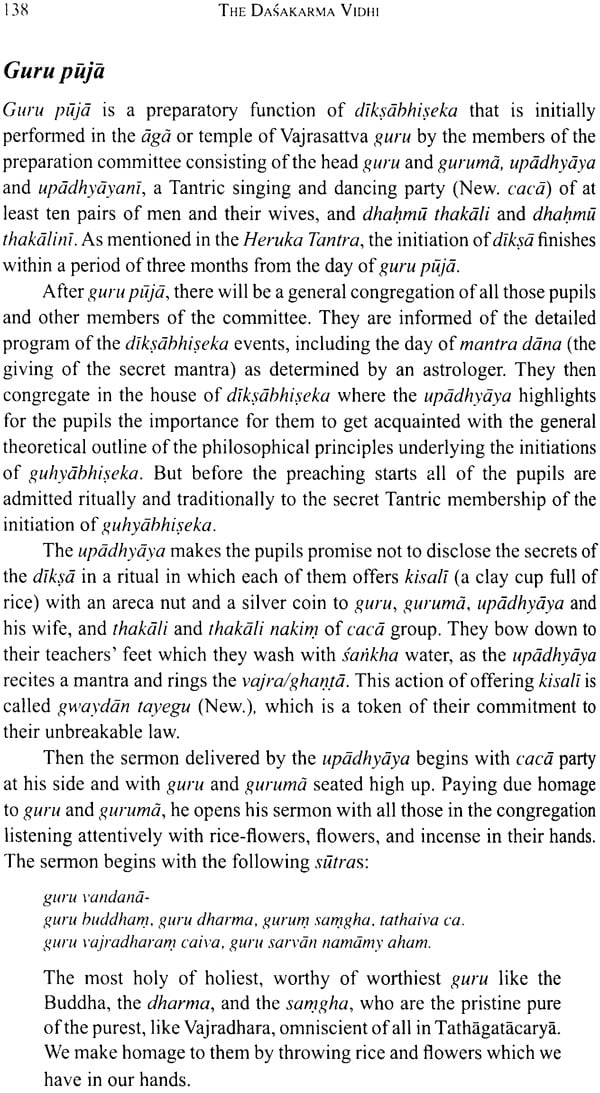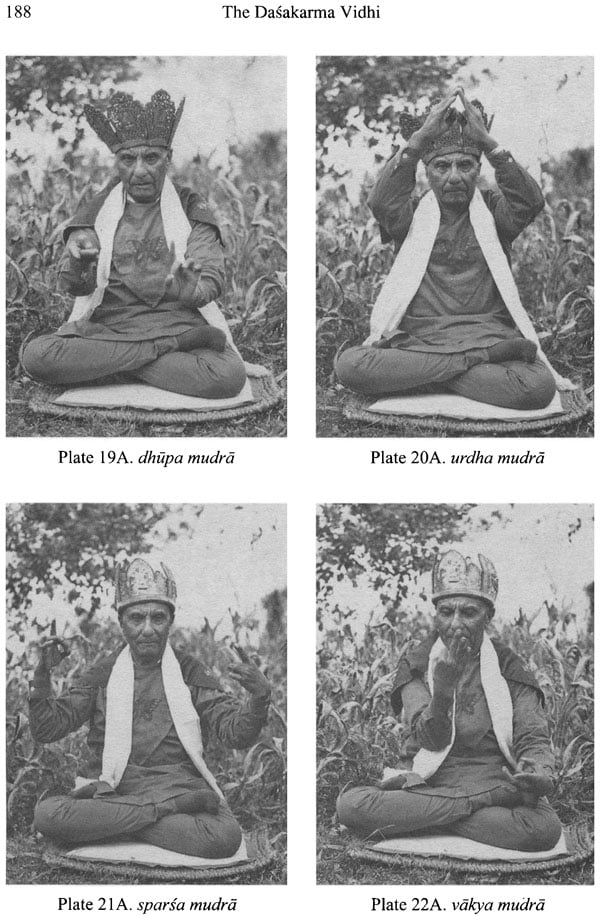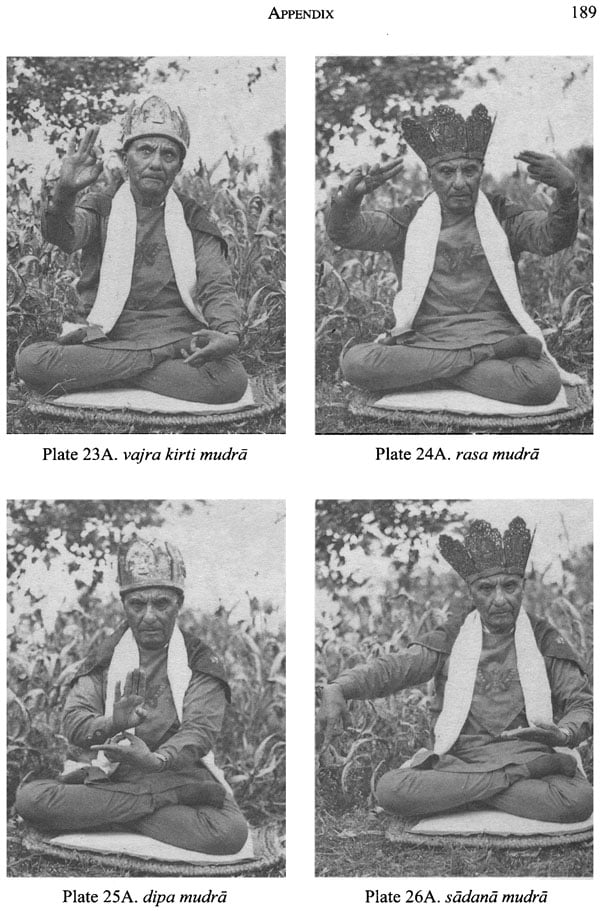
The Dasakarma Vidhi (Fundamental Knowledge on Traditional Customs of Ten Rites of Passage Amongst the Buddhist Newars)
Book Specification
| Item Code: | NAM356 |
| Author: | Pandit Vaidya Asha Kaji and Michael Allen |
| Publisher: | Mandala Book Point, Nepal |
| Language: | English |
| Edition: | 2010 |
| ISBN: | 9789994655144 |
| Pages: | 200 (52 B/W and 16 Color Illustrations) |
| Cover: | Paperback |
| Other Details | 8.5 inch x 5.5 inch |
| Weight | 270 gm |
Book Description
Asha Kaji Vajracharya (b. 1908 - d. 1992) was one of twentieth-century Nepal's most respected Buddhist figures. Having cultivated the traditional learning of a pandit, he became renowned in his native Lalitpur as an Ayurvedic doctor, tantric practitioner and raconteur of Buddhist lore. He published over thirty books, many of which were translations or commentaries based on Sanskrit originals, and opened up his own manuscript collection to photography by the Nepal- German Manuscript Preservation Project. He advised and collaborated with a number of foreign scholars, and became the first Newar master to teach the Buddhist tradition of the Kathmandu Valley outside Asia, touring Japan at his students' request, and bestowing initiation into the cycle of Cakrasamvara upon a non-Newar couple for the first time in the modern era. He is survived by two sons, Saddharmaraj and Mahisvararaj, who are also well- known Buddhist teachers in Lalitpur.
Michael Allen was born in Dublin, Ireland, in 1928. He received his B.A. degree in Philosophy from Trinity College, Dublin in 1950 and his Ph.D. in Social Anthropology from the Australian National University in 1965. He was appointed to a lectureship in Anthropology at Sydney University in 1964 and retired as Professor in 1993. In addition to his extensive fieldwork on Newar society and religion, conducted mainly between 1966 and 1978, Professor Allen has also carried out anthropological research in Vanuatu (1958-82) and in Ireland (1988-96). He established an international reputation with his first book, Male Cults and Secret Initiations in Melanesia (1967). Other important publications include The Cult of Kumari. Virgin Worship in Nepal (1996), Ritual, Power and Gender: Explorations in the Ethnography of Vanuatu, Nepal and Ireland (2000) and his edited collections Vanuatu: Politics, Economics and Politics in Island Melanesia (1981), Women in India and Nepal (1982, with S.N. Mukherjee) and Anthropology of Nepal: Peoples, Problems and Processes (1994).
The dasakarma vidhi (ten rites of passage) are performed in two different ways, namely jnana sambhara and karma sambhara. The former refers to the prerequisites of spiritual knowledge, whereas the latter refers to the prerequisites of action. Even the Buddha is said to have spiritually performed the dasakarma before he attained Buddhahood. It is said amongst the Buddhist Newars of the Kathmandu valley and elsewhere that one cannot achieve enlightenment without performing the dasakarma, either spiritually or ritually. The dasakarma begin with the birth ceremony (jatabhiseka) and end in the ceremonial initiation of the Supreme Seniormost or Head of the Community (cakresvarabhiseka). The system of the dasakarma is so instilled in the life of every Buddhist Newar that the rites have become part and parcel of the life-cycle, thus presenting as inseparable traditional and cultural rites unique among human beings on earth.
The practices of dasakarma were initially performed by King Pracanda Deva of Gaud (India), who is said to have come to Nepal on a pilgrimage to pay homage to Svayambhu. This king, being highly inspired by the supreme serenity and spiritual tranquility of the Svayambhu jyoti rupa- the rays radiating from Svayambhu-made up his mind to renounce his kingship and sought ordination of cudakarmabhiseka (first initiation of entry into the life of homelessness), subsequently followed by acaryabhiseka (initiation into priestly life) bestowed on him by Manjusri. By thus performing the dasakarma vidhi he became the first Vajracarya, who was later known as Santikaracarya, the father of all Vajracaryas in the past and the present.
It is said in the chronicle Nepala Mahatmya Brhat Svayambhu Purana that it was Santikaracarya who built the Svayambhu caitya (stupa) with panca pura-the five consecrated places of Vayupura (air), Agnipura (fire), Nagapura (water), Vasupura (space), and Santipura (earth)-around the Svayambhu stupa. Santipura cave is also named after him, into which he entered and meditated on the practices of sila, samadhi and prajna-the three stepping stones of Buddhism-and attained the eternal goal of immortality.
It was Santikaracarya who founded an unbreakable line of Vajracarya living in samgha (Buddhist community), the leading ones being Gunakara- carya, Bandhudattacarya and Kuladattacarya. All of them are said to have undergone the performances of the dasakarma vidhi. They are also said to have promulgated the definite guidelines of the ritual of dasakarma vidhi in the Kriya Samgraha and the significant explanatory instructions of the guru in the Kriya Samuccaya.
Kuladattacarya is again said to have compiled the books of Kriya Samgraha and Kriya Samuccaya. The whole Tantra, that is, all of the Tantric stanzas together, are known as Subahu pariprccha Tantra, which are the instructive guidelines of the Kriya Samgraha of Dasakarma Vidhi.
The sanctification of images of gods and daitya (devils) is to be followed by some ceremonial rites. In order to purify and consecrate a human life, either physically or spiritually, the dasakarma vidhi is vitally important. It is through the performances of dasakarma vidhi that we will be led to peace and happiness in the life here and hereafter. The dasakarma vidhi consists of ten ceremonial rites beginning from the birth of a baby among Buddhist Newars in general and Vajracarya and Sakya in particular.
The performances of the dasakarma vidhi are mostly based on the books Kriya Samgraha, Kriya Samuccaya and Subahupariprccha Tantra, originally compiled by the famous scholar, Pandit Kuladattacarya, in order to facilitate the performance of rituals practised by priestly Vajracaryas. These performances of dasakarma vidhi are still prevalent among the Newar community of Kathmandu valley.
The following is written in the book Dasakarma Vidhi - Dasakarma Kriya Samgraha:
tatradau sodhana kuryat simantopananayastatha
jata namannaprasana cudamurhutamevaca.
vajracaryah samavartah panigrahana karmani
rajasa ca vivahadi diksasthavirah-karmaca.
ete dasa-kriya yogo nirdesascapi tadyatha
dasakarma vidhanena pratisthamucyate narah.
In this quotation the different forms and stages of dasakarma vidhi are mentioned as follows in order:
1. jati abhiseka or jatabhiseka (the rites of birth). Before the performance of the birth rite, there are three sub-rites of bodily purification, namely (a) kaya sodhana (body purification), (b) simanta kriya, (hair-parting performance) and (c) upanayana kriya (celebration with lights).
2. namabhiseka (naming ceremony).
3. annaprasanabhiseka (rice-feeding ceremony).
4. cudakarmabhiseka (rites of first initiation, general to members of the samgha community.)
5. vajrabhiseka (rites of second higher initiation, which authorise the initiate to be a member of a Vajracarya samgha).
6. svayamvarabhiseka (matrimonial ceremony).
7. diksabhiseka (secret initiation which entitles entry into the aga [New.], Tantric worship-room of the bahah. [New.]).
8. sthavirabhiseka (initiation of the aju [New.] who should be either five or ten in number and are the seniormost members of the bahah).
9. bhimarathabhiseka (ceremonies performed during old age).
10. cakresvarabhiseka (initiation of casalaju [New.], who is the seniormost aju of the bahah).
Kaya sodhana is performed for the purification of the body of a baby by bathing it in a holy river. This is followed by the simanta kriya ceremony in which the baby is sprinkled with cow's milk. Then the pancamrta, which are pills made of five ingredients, such as cow-curd, cow-milk, cow-ghee, honey and jaggery, are given to the baby for eating. Then the body of the baby is gently touched with a vajra to signify the washing off of the ritual pollution incurred through its exit from the mother's womb, which is regarded as unholy and impure.
The ceremony to give blessing and success known as upanayana is then performed. The phuki (New. consanguineal members of families on the father's side) are invited and fed. The most important items of the feast are imu (New. tiny seeds of a medicinal herb), palu (New. ginger) and caku (New. molasses). Then the paju khalah (New. the family of the mother of the baby) is informed of the birth of a new baby. An areca nut, molasses and ginger are sent to the maternal family to indicate the birth of a baby boy. In the case of a baby girl only half of an areca nut is sent. The maternal family send an equal amount of the same things in return, indicating acknowledgment of the birth of the new baby.
The phuki family members are said to be in an unholy and impure state and must abstain from any social and religious function as long as the baby has the cord attached to its navel. It is the performance of jatabhiseka (see pp. 31-33) six days after birth that ends the state of unholiness. Generally the baby's cord is cut off by a woman belonging to the butcher caste (New. Nai) two days after the birth. Some babies born in hospital are exempted from the rituals of kaya sodana, simanta and upanayana. Some families perform these ceremonies when the baby is brought back home from the hospital. The Nai woman is given some quantity of rice grain, sesame seeds, seeds of black dhal, peas and oats. The next day the purohit is given dana (alms) and an offering of the above-mentioned grains are made at the chwasah (New. the junction of certain cross-roads) to appease the bhuts and prets (ghosts and spirits) who reside there. When these three preliminary ceremonies, which signify the purification of the newly born baby, are performed, the ten dasakarma vidhi follow one after another as occasion arises, beginning with jatabhiseka.
Outline of dasakarma vidhi
(I) jatabhiseka ceremony, which qualifies the new-born baby to be admitted to the caste to which his family belongs.
(2) namabhiseka, which means name-giving ceremony, occurs generally on the fourth or the sixth day after birth. The Newar name of these two ceremonies, which are often performed together, is macabu bemkegu
(3) annaprasanabhiseka (New. jakwa) is performed at the age of six months for a baby boy and five months for a baby girl. In this first-feeding ceremony the baby is introduced to kula devata, the family or lineage god, and offers areca nut, coins, rice flower (New. tay) rice grains, red powder (abhir, Skt., or abir; New.) and orange powder (sinhah, New.). The first food given to the baby consists of banana, the five nectars (pancamrta), bean soup, milk rice (New. khira) and boiled rice (New. ja). Among some Newar Hindus the food may be non-vegetarian, but mostly it is vegetarian. According to the book Lalitavistara Sutra (the life story of the Lord Buddha), the first food is strictly vegetarian.
(4) cudakarmabhiseka is the first ordination which entitles a boy to become a member of the Buddhist community (samgha) to which his family belongs. This ceremony is generally performed when the boy is between five and twelve years of age. The ceremony is popularly known as bare chuyegu (New.) and is performed in the bahah (monastery) to which his lineage belongs. After the ordination the boy is called Sakya Bhiksu or Cailaka Bhiksu Sakya or Buddhacarya Bhiksu Sakya. Some boys who are ordained in bahi are known as Brahmacarya Bhiksu Sakya.
(5) vajracaryabhiseka (New. acah luyegu) is the initiation which promotes a Sakya Bhiksu to a higher status, namely Vajracarya. After this initiation he becomes a member of a Vajracarya samgha. A Vajracarya, if he wishes, has the authority to act as purohit (priest) to perform rites and ceremonies for his clients (jajaman). In vajracaryabhiseka, he makes a vow that he will be a staunch follower of Vajrasattva guru, dedicating his life to the happiness and compassion for the many. Being pure in mind, he will be dutiful in performing right action and indifferent to wrong actions.
(6) svayamvarabhiseka is the ceremony performed when a person gets married. The union of male and female is considered to be important in the life of Buddhist Newars in general and Vajracaryas in particular. When the married couple live in peace and happiness through their conjugal life, the living of such a life is known as sahajayana kriya. A married couple is considered to be one in sahajayana. A striking example of the single unity of a married couple is shown when the bride and bridegroom eat together from the same plate (New. thaybhu) in the matrimonial ceremony. As a married couple they learn to overcome the problems and difficulties of domestic life through which they must pass in order to be well experienced in the worldly hardships of ups and downs.
(7) diksabhiseka is the higher Tantric initiation given to those who wish to acquire the knowledge of Tantric practices called Tantrayana kriya. This is also known as prajna-upaya carya. Prajna means wisdom and upaya the unifying method.
(8) sthavirabhiseka is an initiation performed when a member of a samgha in a bahah reaches the age of being an aju. There are either five or ten ajus in a monastery, depending upon the size of the samgha. These ajus are the seniormost members of the samgha.
(9) bhimarathabhiseka, candrarathabhiseka and devarathabhiseka are three highly solemnised ceremonies performed in old age. They are called bura jakwa (New.). The first, bhimarathabhiseka, is performed at the age of 77 years 7 months and 7 days; then the second, candrarathabhiseka, is done at 82 years of age, and the third, devarathabhiseka, at the age of 90. These old-age ceremonies are observed with pomp and grandeur by Buddhist as well as Hindu Newars as a warning before entering into Yama Loka, the world of the expired.
(10) cakresvarabhiseka is the final highly solemnised initiation, or the last one of the ten rites of passage performed when one of the ajus becomes seniormost among the seniors (ajus). After cakresvarabhiseka, he becomes samgha nayaka, the leading seniormost member of the bahah (monastery) and is referred to as the Cakresvara aju (Casalaju), who by right is both the pujari and dyahpahlah (New. god guardian, the performer of temple puja and the one who confers the secret mantras for cudakarmabhiseka and vajracaryabhiseka in the monastery aga).
| A Tribute in Memory of Asha Kaji Pandit (Michael Allen) | 1 | |
| In Memoriam, Asha Kaji Pandit (David N. Gellner) | 17 | |
| A Tribute to Pandit Asha Kaji (Min Bahadur-Shakya) | 21 | |
| Preface | 23 | |
| Introduction | 25 | |
| Outline of dasakarma vidhi | 27 | |
| Stri kriya - rituals for women | 30 | |
| 1 | Jatabhiseka kriya - birth-purification ceremony | 31 |
| 2 | Namabhiseka (or namakarana) - name-giving ceremony | 35 |
| 3 | Annaprasanabhiseka - first rice-feeding ceremony | 37 |
| 4 | Cudakarmabhiseka - Buddhist boys' initiation | 41 |
| Gway dana tayegu - offering of areca nuts | 43 | |
| Upasaka vidhi - Buddhist householder regulations | 44 | |
| Excursus from a vamsavali | 45 | |
| The eve of monastic initiation | 47 | |
| The different categories of cudakarmabhiseka | 47 | |
| Origin of Gautama Buddha and the Sakya clan | 48 | |
| Upasaka carya (dusala kriya) - preliminary ceremony | 52 | |
| Kesachedana kriya or busa kayegu - hair-shaving | 56 | |
| Namabhiseka for bhiksu - name-giving | 57 | |
| The guru's sermon | 58 | |
| Caturarya satya - the four noble truths | 63 | |
| Pratitya samutpada - the wheel of life | 63 | |
| Lasakusa puja - welcome-back ceremony | 74 | |
| Chyakwakayegu vidhi - disrobing ceremony | 76 | |
| Mata puja - lamp ceremony | 82 | |
| 5 | Vajracaryabhiseka (acah luyegu) - initiation into Vajrayana | 87 |
| Udakabhiseka - purifying ceremony | 92 | |
| Mukutabhiseka - conferring of the 'crown' | 92 | |
| Vajrabhiseka - the giving of the vajra | 94 | |
| Ghantabhiseka - the giving of the ghanta | 95 | |
| Namabhiseka - name-giving | 96 | |
| Mantrabhiseka - the giving of the mantra | 98 | |
| Second stage of vajracaryabhiseka | 103 | |
| 6 | Ihi vidhi - initiation of young girls | 109 |
| Second day of ihi vidhi | 113 | |
| 7 | Baray tayegu - confinement ceremony of young girls | 117 |
| Rajasa vidhi - the rituals of baray tayegu | 119 | |
| 8 | Vivaha mahotsav - wedding ceremonies | 123 |
| Lasakusa - welcoming ceremony | 128 | |
| Kesabandhana - groom oils bride's hair | 130 | |
| Mukha darsan - seeing bride's face | 133 | |
| Dukayekegu jilajam - reception in bride's house | 134 | |
| Samji swayegu - entertainment of parents of bride and groom | 134 | |
| 9 | Diksabhiseka or guhyabhiseka - initiation into Tantrayana | 137 |
| Guru puja - guru worship | 138 | |
| Pitha puja - 'power-place' worship | 144 | |
| Uposadha vrata - fasting vow | 149 | |
| Kilanyasa vidhi - nail-protection procedures | 150 | |
| Mandala pratistha vidhi - mandala consecration | 153 | |
| Sisyadhivasana - deity invocation | 155 | |
| Viracarya - hero performance | 157 | |
| Viracarya puja | 170 | |
| Ki mandala puja | 171 | |
| Astamangala - eight blessings | 171 | |
| Dasabhiseka - ten initiations | 174 | |
| Mansahuti sirahuti - symbolic human head sacrifice | 174 | |
| Raja pravaha kriya of mandala | 176 | |
| Diksa daru | 177 | |
| 10 | Vrddha upanayana kriya - old-age ceremonies | 179 |
| Bhimaratha | 179 | |
| Devaratha | 180 | |
| Maharatha | 181 | |
| 11 | Appendix 1. Pandit Asha Kaji demonstrates 32 Vajrayana mudra (Plate l A to Plate 32A) | 183 |


